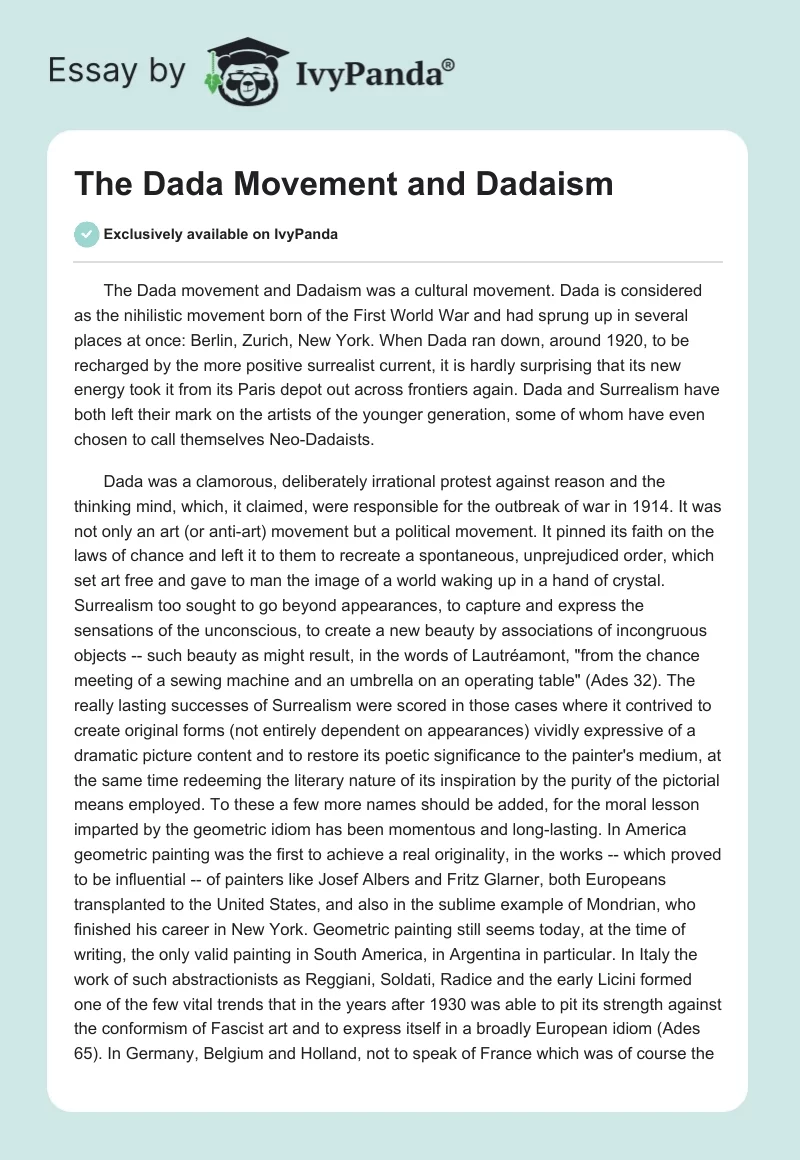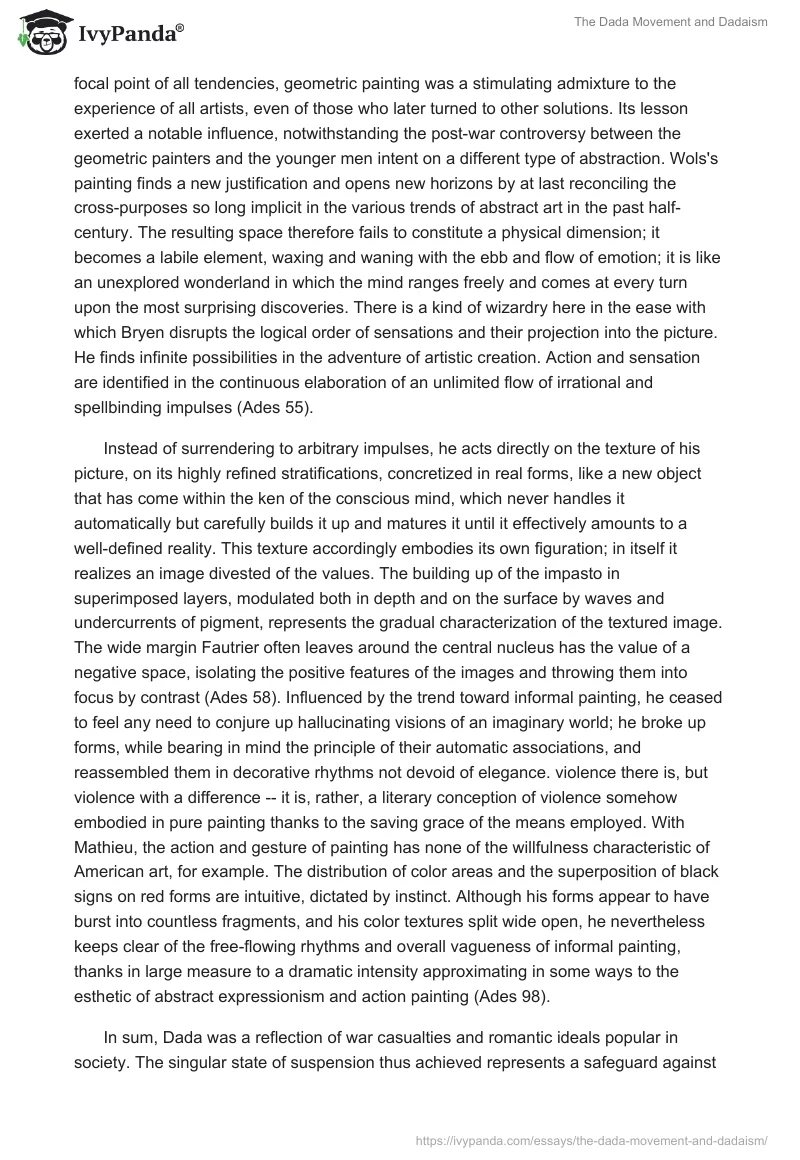The Dada movement and Dadaism was a cultural movement. Dada is considered as the nihilistic movement born of the First World War and had sprung up in several places at once: Berlin, Zurich, New York. When Dada ran down, around 1920, to be recharged by the more positive surrealist current, it is hardly surprising that its new energy took it from its Paris depot out across frontiers again. Dada and Surrealism have both left their mark on the artists of the younger generation, some of whom have even chosen to call themselves Neo-Dadaists.
Dada was a clamorous, deliberately irrational protest against reason and the thinking mind, which, it claimed, were responsible for the outbreak of war in 1914. It was not only an art (or anti-art) movement but a political movement. It pinned its faith on the laws of chance and left it to them to recreate a spontaneous, unprejudiced order, which set art free and gave to man the image of a world waking up in a hand of crystal. Surrealism too sought to go beyond appearances, to capture and express the sensations of the unconscious, to create a new beauty by associations of incongruous objects — such beauty as might result, in the words of Lautréamont, “from the chance meeting of a sewing machine and an umbrella on an operating table” (Ades 32). The really lasting successes of Surrealism were scored in those cases where it contrived to create original forms (not entirely dependent on appearances) vividly expressive of a dramatic picture content and to restore its poetic significance to the painter’s medium, at the same time redeeming the literary nature of its inspiration by the purity of the pictorial means employed. To these a few more names should be added, for the moral lesson imparted by the geometric idiom has been momentous and long-lasting. In America geometric painting was the first to achieve a real originality, in the works — which proved to be influential — of painters like Josef Albers and Fritz Glarner, both Europeans transplanted to the United States, and also in the sublime example of Mondrian, who finished his career in New York. Geometric painting still seems today, at the time of writing, the only valid painting in South America, in Argentina in particular. In Italy the work of such abstractionists as Reggiani, Soldati, Radice and the early Licini formed one of the few vital trends that in the years after 1930 was able to pit its strength against the conformism of Fascist art and to express itself in a broadly European idiom (Ades 65). In Germany, Belgium and Holland, not to speak of France which was of course the focal point of all tendencies, geometric painting was a stimulating admixture to the experience of all artists, even of those who later turned to other solutions. Its lesson exerted a notable influence, notwithstanding the post-war controversy between the geometric painters and the younger men intent on a different type of abstraction. Wols’s painting finds a new justification and opens new horizons by at last reconciling the cross-purposes so long implicit in the various trends of abstract art in the past half-century. The resulting space therefore fails to constitute a physical dimension; it becomes a labile element, waxing and waning with the ebb and flow of emotion; it is like an unexplored wonderland in which the mind ranges freely and comes at every turn upon the most surprising discoveries. There is a kind of wizardry here in the ease with which Bryen disrupts the logical order of sensations and their projection into the picture. He finds infinite possibilities in the adventure of artistic creation. Action and sensation are identified in the continuous elaboration of an unlimited flow of irrational and spellbinding impulses (Ades 55).
Instead of surrendering to arbitrary impulses, he acts directly on the texture of his picture, on its highly refined stratifications, concretized in real forms, like a new object that has come within the ken of the conscious mind, which never handles it automatically but carefully builds it up and matures it until it effectively amounts to a well-defined reality. This texture accordingly embodies its own figuration; in itself it realizes an image divested of the values. The building up of the impasto in superimposed layers, modulated both in depth and on the surface by waves and undercurrents of pigment, represents the gradual characterization of the textured image. The wide margin Fautrier often leaves around the central nucleus has the value of a negative space, isolating the positive features of the images and throwing them into focus by contrast (Ades 58). Influenced by the trend toward informal painting, he ceased to feel any need to conjure up hallucinating visions of an imaginary world; he broke up forms, while bearing in mind the principle of their automatic associations, and reassembled them in decorative rhythms not devoid of elegance. violence there is, but violence with a difference — it is, rather, a literary conception of violence somehow embodied in pure painting thanks to the saving grace of the means employed. With Mathieu, the action and gesture of painting has none of the willfulness characteristic of American art, for example. The distribution of color areas and the superposition of black signs on red forms are intuitive, dictated by instinct. Although his forms appear to have burst into countless fragments, and his color textures split wide open, he nevertheless keeps clear of the free-flowing rhythms and overall vagueness of informal painting, thanks in large measure to a dramatic intensity approximating in some ways to the esthetic of abstract expressionism and action painting (Ades 98).
In sum, Dada was a reflection of war casualties and romantic ideals popular in society. The singular state of suspension thus achieved represents a safeguard against the lure of romantic impulses. So in keeping with the spirit of the age, Dadaists rejected visual appearances out of hand as incapable of conveying the full force of emotions.
Works Cited
Ades, D. The DADA Reader: A Critical Anthology. University Of Chicago Press, 2006.


